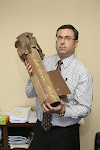The Jerusalem Festival of Light is in its fourth year, and what makes it continue to work is its location in the Old City, bringing tourists and all kinds of locals out to enjoy the thoughtfully crafted light sculptures, viewed while walking through the usually darkened cobblestoned streets and alleyways.
Here’s our favorite five from the festival:
Yoav Homsky's Zinorot at the Davidson Center (Courtesy Jerusalem Festival of Light)
1) Yoav Homsky’s Zinorot tree is located immediately outside the Western Wall plaza, at the entrance of the Southern Wall section of the temple mount. The bare tree, comprised of only lighted branches without leaves, can be heard and seen from all of the roofs of the Old City. The tree’s musical accompaniment progresses from a very simple beat to more complex music as the tree begins to light up just at the center of specific branches, until the whole area glows from the tree’s burnt orange luminescence. (Located next to the Western Wall security car and bus drop-off point, this is the most easily wheelchair accessible sculpture of the festival.)
Clear by Malki Shem-Tov (Courtesy Jerusalem Festival of Light)
2) Those who are more ready and able to walk the festival’s orange trail through the Armenian and Jewish Quarters will encounter the Earth Harp. Created by William Close and Scott Passaglia, the harp’s cables are strung up to a roof and Close plays a novel cacophony of strings, consistently dramatic in both major and minor that accompany CLEAR, Malki Shem-Tov’s three-dimensional projections on the building next-door. Close has played the harp in some fairly awe-inspiring places, from mountain peaks to the Seattle Space Needle and the Coliseum in Rome, but commented that in terms of amazing places, Jerusalem “is up there for sure.”
A Mayamuna performance (photo credit: Kobi Gideon/Flash 90)
3) Mayumana’s Currents is a great option for those who don’t want to walk around the festival’s many mapped trails. As one of only two events with an entrance fee at the festival, (NIS 80 per ticket or a discounted NIS 55 for Orange cellphone customers), Currents combines guitar solos, tap dancing and chanting by the Mayumana team of ten dancer-acrobat-percussionists, offering 45 minutes of orchestrated madness.
4) If you’re not interested in dedicating yourself to a full Festival of Light extravaganza, head to Jaffa Gate to see the Cupola (impressive even during the day), a 25-meter-high dome by Luminarie De Cagna, an Italian family lighting company. The dome of the Cupola resembles a building from the Italian Renaissance, and is made from LED lights, chained into curtains of light that are mounted onto a wooden structure. You can see the Cupola from the sidewalk of the Mamilla Mall below, but it’s even more impressive up close.
Windows of the Cathedral (Courtesy Jerusalem Festival of Light)
5) As long as you’re in the Old City, give some consideration to the mix of religions, and visit the only installation that isn’t actually light-related. Cathedral, by Raoul Kurvitz of Estonia, is a church-based building made of discarded windows and window frames, not electricity related per se, but offering plenty of light, both spiritual and actual, in its panes of glass.
The Jerusalem Festival of Light runs from June 6-14, from 8 pm to 12 am (closed Friday until Saturday at 9 pm)
The Mayumana performance times are June 7,10-12: 8 pm and 10 pm; June 9, 9 pm and 10:30 pm; June 13-14: 8 pm, 9 pm and 10 pm.
The Mayumana performance times are June 7,10-12: 8 pm and 10 pm; June 9, 9 pm and 10:30 pm; June 13-14: 8 pm, 9 pm and 10 pm.

